Explore Uganda’s Rich Birding Heritage
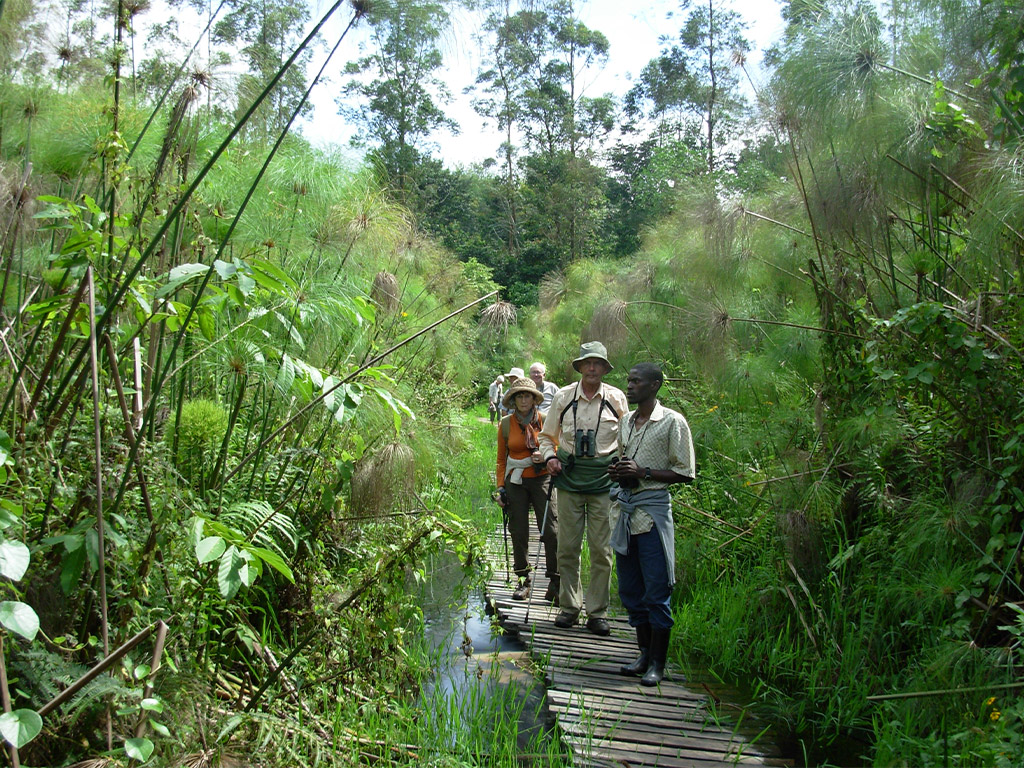 clients engaging in birding activities in Bigodi Wetland Sanctuary, near Kibale, Uganda
clients engaging in birding activities in Bigodi Wetland Sanctuary, near Kibale, Uganda
Engage in an unforgettable birding adventure in Uganda with Zootopia Game Drive safaris. Discover diverse avian species and pristine natural habitats on our Uganda Birding Tours and Trips. Experience the magic of birding in Uganda with us.
Uganda, known as the ‘Pearl of Africa,’ is a country of astounding beauty and immense potential in East Africa. From the captivating source of the White Nile on Lake Victoria to the snow-capped Rwenzori Range, and the lush forests of the Virunga volcanoes housing the endangered Mountain Gorillas, Uganda offers a remarkable variety of landscapes. With its awe-inspiring Murchison Falls and vast savannas, the country showcases a remarkable contrast. Uganda’s exceptional diversity of habitats contributes to an impressive bird list of over 1100 species, including the most sought-after treasures like the Shoebill, Grey Crowned Crane, and stunning endemics of the Albertine Rift Valley. Despite its relatively small size, comparable to Great Britain or Oregon, Uganda stands as one of Africa’s richest destinations for birding, hosting a remarkable array of birds and wildlife.
Uganda birding offers a feast of rare and colorful species, and the chance to improve dramatically on your species life list. More than 1,065 bird species inhabit a range of habitats – from montane forests to wetlands, agricultural lands, lakes and savannahs.
Uganda is on the equator, and the endemic species-rich Albertine Rift valley separates the west of the country from DR Congo and Rwanda, so expect impressive biodiversity.
In no particular order, here are arguably the best birding spots in Uganda:
1. Mabamba Swamp at Lake Victoria
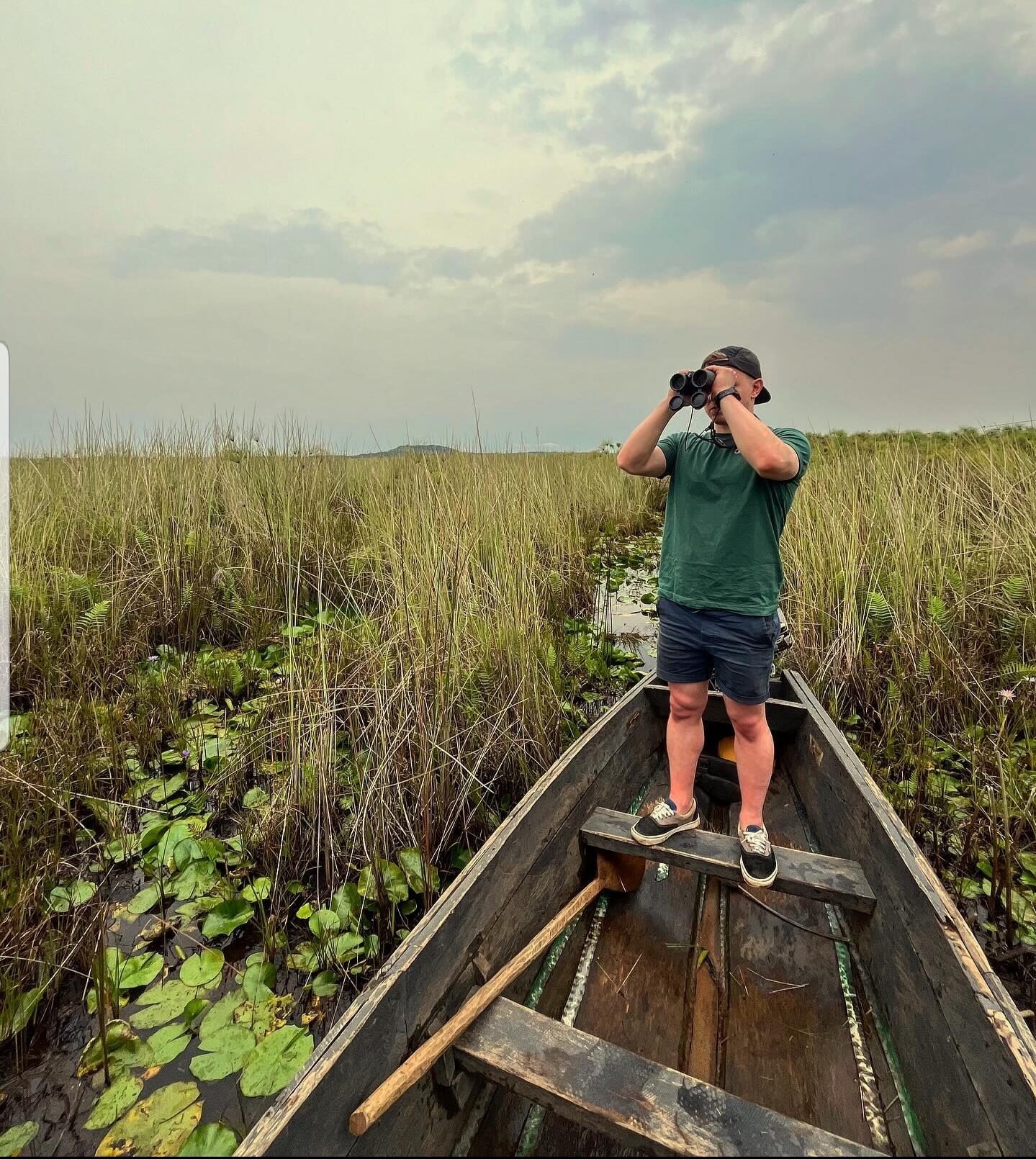 Searching for shoe bills in Mabamba Swamp, near the airport city of Entebbe, Uganda
Searching for shoe bills in Mabamba Swamp, near the airport city of Entebbe, Uganda
Mabamba Swamp is one of the best places to catch a glimpse of the highly-prized shoe bill. Lake Victoria is the largest freshwater body in Africa and is home to about 260 bird species.
Look out for the shoe bill, blue swallow, pallid harrier, papyrus gonolek, swamp flycatcher, pigmy goose, lesser jacana, white-winged warbler, Viollet’s weaver, grosbeak weaver, palm-nut vulture, black-headed weaver, northern brown-throated weaver, Clarke’s weaver and Carruthers cisticola.
Mabamba Bay Wetland: A Birdwatcher’s Paradise
Mabamba Bay Wetland is a wetland area located on the northern shores of Lake Victoria, just a short drive from Uganda’s capital city, Kampala. Covering an area of approximately 16,500 hectares, this wetland is renowned for its exceptional birdwatching opportunities. As you explore the maze of papyrus and waterways, you’ll be treated to a stunning display of over 300 bird species.
Uganda Birding Destinations
If you’re searching for the best birding destinations in Uganda, Mabamba Bay Wetland deserves a top spot on your list. Here are some of the reasons why:
- Shoebill Stork Encounters: Mabamba Bay Wetland is one of the best places in the world to see the elusive Shoebill stork, a bird with a massive, shoe-shaped bill. This prehistoric-looking bird is a must-see for bird enthusiasts and wildlife photographers.
- Diverse Avian Species: Beyond the Shoebill stork, Mabamba Bay Wetland is home to a remarkable variety of bird species, including African waterfowl, kingfishers, herons, and many more. The wetland’s unique habitat attracts both resident and migratory birds throughout the year.
- Scenic Beauty: The wetland’s serene and picturesque surroundings make it an ideal location for birdwatching. The tranquil waterways, lush vegetation, and expansive lake views create a magical ambiance for your birding adventures.
Birding in Uganda: Mabamba Bay Wetland’s Unique Ecosystem
Mabamba Bay Wetland boasts a unique ecosystem characterized by a labyrinth of papyrus reeds, open water channels, and floating vegetation. This diverse habitat provides shelter and sustenance for a wide range of bird species. The wetland is part of the larger Ramsar site, Lake Victoria Basin, recognizing its ecological importance.
The Shoebill Stork: Mabamba’s Crown Jewel
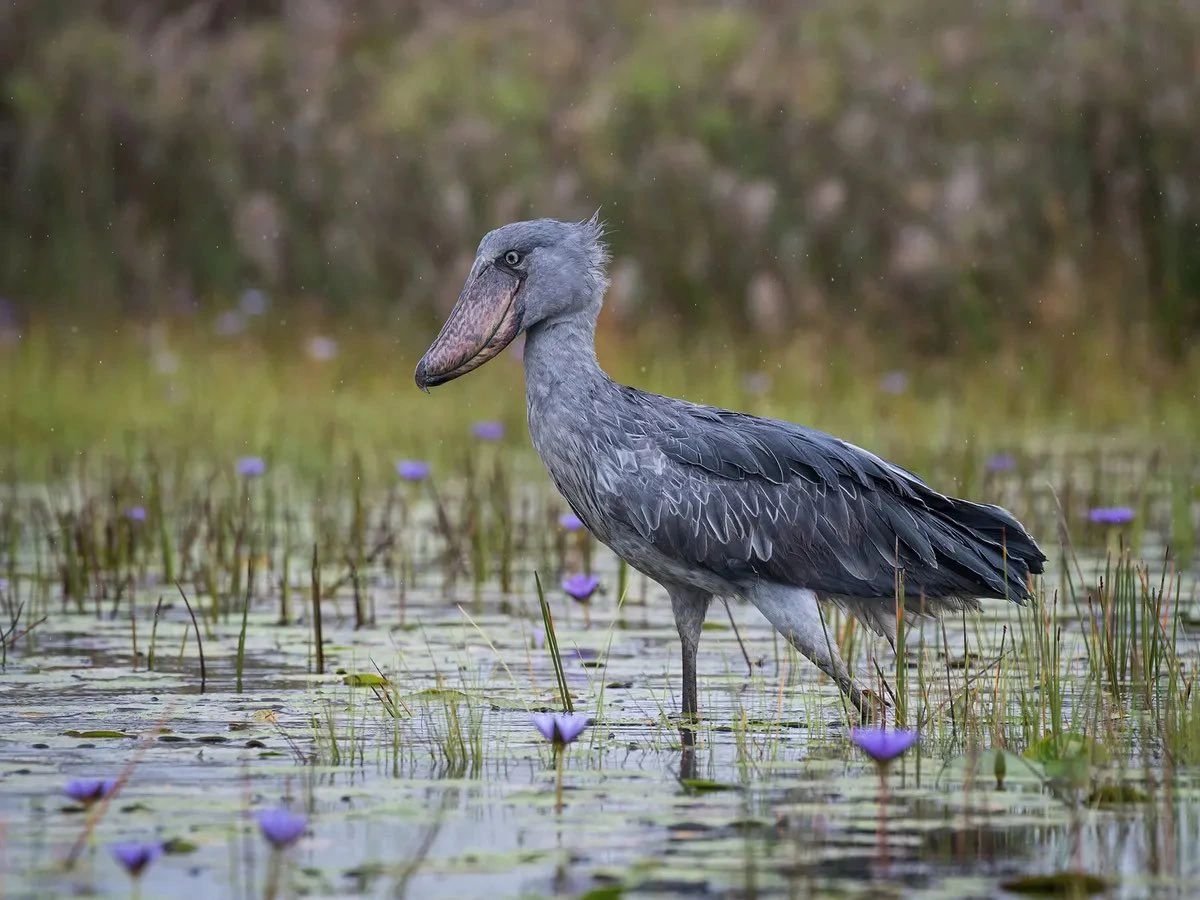
One of the most sought-after bird species at Mabamba Bay Wetland is the Shoebill stork. This large and enigmatic bird, with its enormous shoe-shaped bill, is a true icon of the wetland. Mabamba Bay Wetland offers an excellent chance to spot the Shoebill stork in its natural habitat, making it a dream come true for birders.
Uganda Birding Tours at Mabamba Bay Wetland
To make the most of your birding experience in Mabamba Bay Wetland, consider joining one of the many guided birding tours available in Uganda. These tours are led by experienced ornithologists and local guides who know the area intimately. They’ll take you to the best birding spots, ensuring you don’t miss any of the avian treasures that call Mabamba home.
Birding Spots in Uganda: Explore Mabamba Bay Wetland
Mabamba Bay Wetland is more than just a single birding spot; it’s a haven of interconnected habitats. As you explore the wetland, you’ll come across various birding hotspots, each offering a unique set of species and experiences:
- Mabamba Swamp: This is the heart of birding in Mabamba. The extensive papyrus swamps and open water channels here are where you’re most likely to spot the Shoebill stork and numerous other waterfowl.
- Makanga Hill: For a panoramic view of the wetland and its surroundings, Makanga Hill provides a fantastic vantage point. Here, you can observe raptors and other birds soaring overhead.
- Lwaji Island: A visit to this island lets you explore the interior of the wetland, offering a different perspective on its birdlife.
- Kasanje Village: The nearby village provides opportunities to witness traditional fishing methods and the interaction between local communities and the wetland’s rich biodiversity.
Mabamba Bay Wetland is a jewel in the crown of Uganda’s birding destinations. With its exceptional bird species, Shoebill stork sightings, and breathtaking natural beauty, it’s a must-visit for any bird enthusiast. Whether you’re an experienced birder or a novice nature lover, Mabamba Bay Wetland promises an unforgettable birdwatching experience. Start planning your birding adventure today and discover the avian wonders of Mabamba Bay Wetland.
2. Bwindi Impenetrable Forest National Park
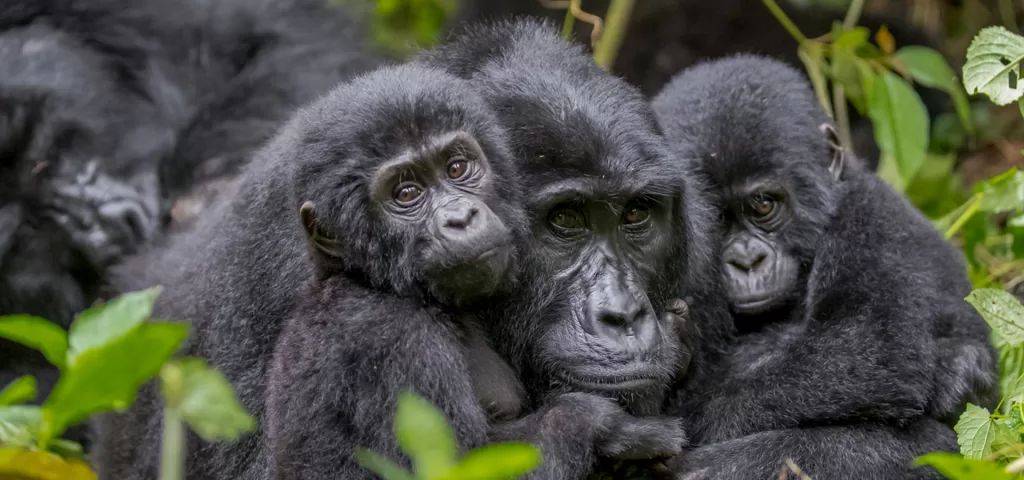 Gorilla Mother in Bwindi with her twin babies.
Gorilla Mother in Bwindi with her twin babies.
Bwindi is the heart and soul of Ugandan birding, the make-and-breaker of bird lists and the home of many endemic and rare bird species. This forested heaven boasts about 350 species, including 23 Albertine Rift endemics of which 14 are not recorded anywhere else in Uganda.
The forest trails around Buhoma are ALIVE with opportunity as you stand your best chance to catch a glimpse of olive long-tailed cuckoo, bar-tailed trogon, dusky tit, Abyssinian (Kivu) groundthrush, white-bellied robin-chat, equatorial akalat, grey-chested iladopsis, red-throated alethe, white-bellied crested flycatcher, white-eyed slaty flycatcher.
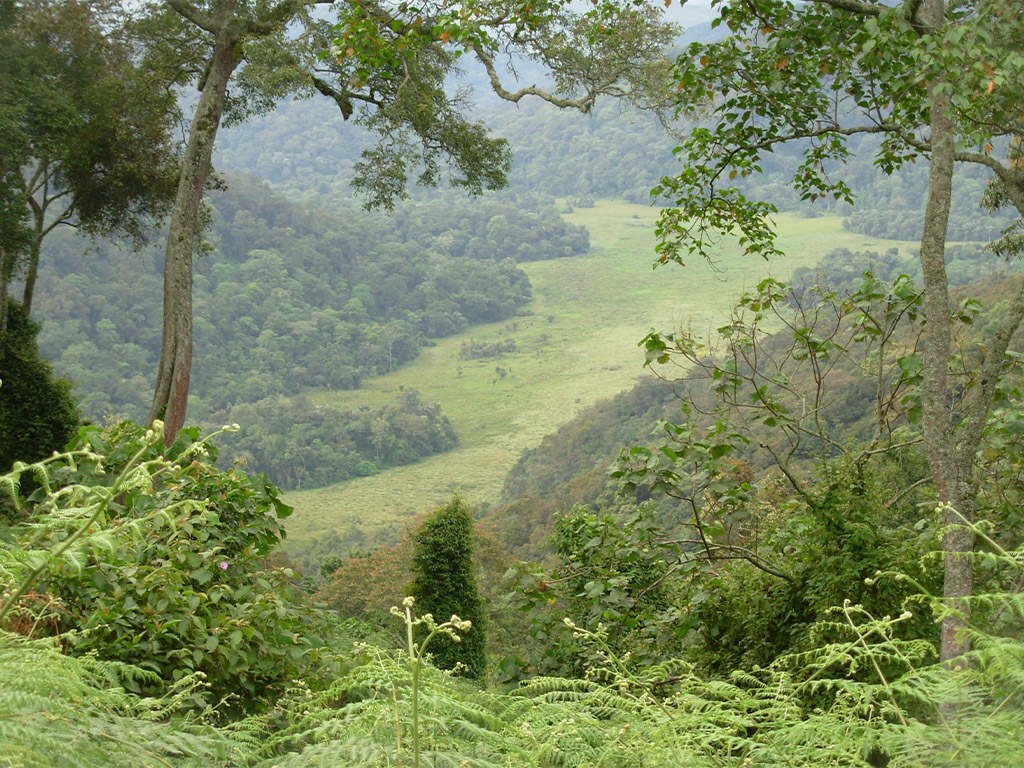 Mubwindi Swamp, Bwindi Impenetrable Forest National Park, Uganda
Mubwindi Swamp, Bwindi Impenetrable Forest National Park, Uganda
Top Birding Spots in Bwindi Forest
Explore Bwindi’s remarkable birding destinations:
- Buhoma Sector: This sector is known for sightings of species like the African Blue and White-tailed Blue Flycatchers. Unique human-avian interactions can be found in adjacent communities and tea plantations.
- Ruhija Sector: A must-visit for avid birders, this area offers species like Grauer’s Swamp Warbler, Grauer’s Broadbill, and the stunning Regal Sunbird.
- Nkuringo Sector: Nkuringo boasts the Purple-breasted Sunbird, Handsome Francolin, and numerous other bird species. It’s also renowned for panoramic views of the Virunga Volcanoes.
The enigmatic Chapin’s flycatcher, white-browed crombec, Neumann’s warbler, black-faced prinia, handsome francolin, Jameson’s antpecker, black-faced rufous warbler, northern double-collared sunbird, Will cock’s honeyguide, black bee-eater, black-billed weaver, magpie mannikin and newly described Willard’s sooty boubou.
Scan snags and canopy contours for sooty flycatcher and forest starlings – including Waller’s, Stuhl Mann’s and narrow-tailed.
Transitional areas such as “The Neck,’ between Buhoma and Ruhiza are popular areas to look out for black sparrowhawk, western bronze-naped pigeon, cinnamon-chested bee-eater, Cassin’s honeybird, Petit’s cuckooshrike, white-chinned prinia, mountain wagtail, pink-footed puffback, the rare tiny sunbird and the dapper brown-capped weaver.
Away from the indigenous forests, amongst pioneer vegetation fringing the tea estates you can strike it lucky with the highly sought-after dusky twin spot, yellow-bellied, Kandt’s and black-crowned waxbills, streaky and thick-billed seedeaters, western citril and yellow-crowned canary, noisy Chubb’s cisticola, alert Mackinnon’s shrikes, and with luck marvel at a sigh of the striking Doherty’s bushshrike.
Ruhija is your next hotspot in Bwindi, and although the walk down to Mubwindi Swamp is not for the faint-hearted, this is an obligate pilgrimage for the serious birder, since it is down there that resides the MOST coveted of Bwindi’s Albertine Rift endemics …. the rare and localised Grauer’s broadbill, one of Africa’s most sought-after birds.
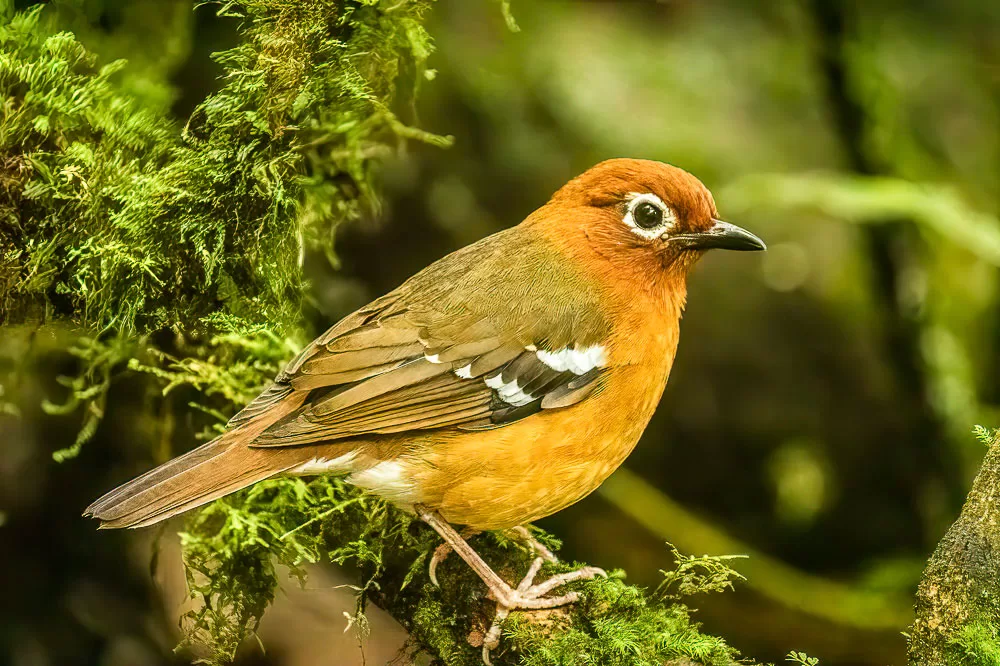
This globally threatened species is only known from two sites in the world, the other being a remote forest in eastern DR Congo.
Other species to watch out for in Ruhija include Carruthers’s cisticola and the localised Grauer’s swamp warbler, red-chested flufftail, black-billed turaco, barred long-tailed cuckoo, white-headed wood-hoopoe, western tinkerbird, olive woodpecker, thick-billed and the elusive dwarf honeyguide, black saw-wing, grey cuckooshrike, olive-breasted and yellow-streaked greenbuls, Abyssinian thrush, white-starred robin,
Archer’s ground-robin, stripe-breasted tit, mountain illadopsis, Rwenzori hill-babbler, mountain masked, Rwenzori, and chestnut-throated apalises, cinnamon bracken, mountain yellow, red-faced woodland and Grauer’s warblers, white-tailed blue flycatcher, yellow-eyed black flycatcher
Rwenzori batis, mountain sooty boubou, the rare Lagden’s bushshrike, Sharpe’s starling, mountain oriole, strange weaver, and oriole finch. Flowering symphonias attract the incredible blue-headed, regal and scarce purple-breasted sunbirds, all highly desired Albertine Rift endemics. Dusky, red-faced and the phantom-like Shelley’s crimsonwing occur here too.
As the sun sets, Ruhija offers your best-bet Rwenzori Nightjar, African wood owl, and if you are exceptionally fortunate, the rare Fraser’s eagle-owl.
Uganda Gorilla Trekking
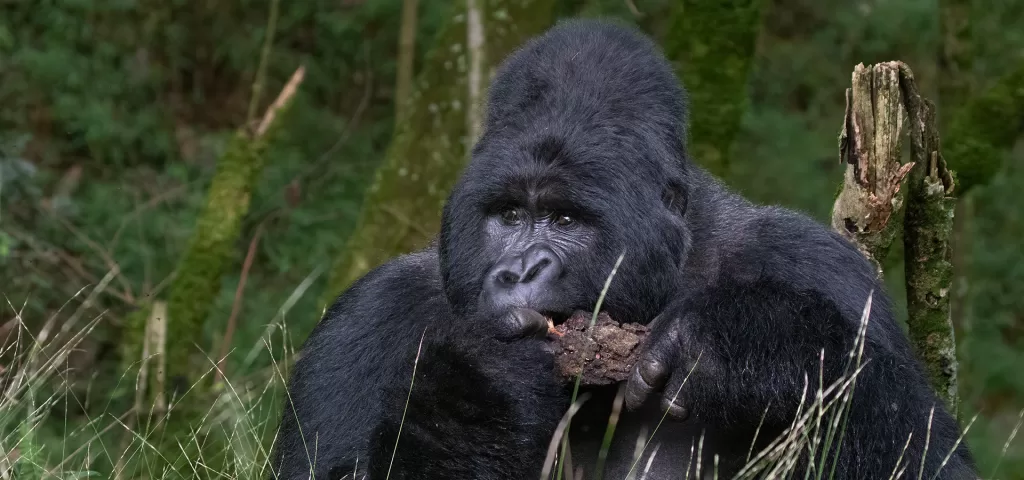
A Once-in-a-Lifetime Adventure – Uganda’s commitment to gorilla conservation and sustainable tourism makes it one of the world’s best places to experience the thrill of encountering mountain gorillas in the wild. Reach out to book
3. Murchison Falls National Park
Nestled in the heart of Uganda, Murchison Falls National Park is a true gem for wildlife and birding enthusiasts. This pristine wilderness, covering approximately 3,840 square kilometers, offers a diverse range of ecosystems and an incredible array of bird species, making it one of the top birding destinations in Uganda. Whether you’re a seasoned birder or a casual nature lover, Murchison Falls National Park is a place you won’t want to miss. Let’s explore why this park is a haven for birdwatchers and why Uganda birding tours should be on your bucket list.
 Murchison Falls, Uganda
Murchison Falls, Uganda
Discovering the Avian Wonders of Murchison Falls National Park
Murchison Falls National Park boasts a rich mosaic of habitats, including savannah grasslands, woodlands, riverine forests, and wetlands. This diversity provides a perfect haven for over 450 bird species that call the park home. Here are some of the avian highlights you can expect to encounter:
- African Fish Eagle: The iconic call of the African Fish Eagle echoes through the park as it soars above the Nile River, showcasing its impressive wingspan and distinctive plumage.
- Goliath Heron: Spotting the largest heron species in the world, the Goliath Heron, is an awe-inspiring experience. These majestic birds can be seen along the riverbanks, patiently waiting to catch their prey.
- Shoebill Stork: Murchison Falls National Park is one of the best places in Uganda to catch a glimpse of the elusive Shoebill Stork, known for its large shoe-shaped bill. The park’s wetlands provide the perfect habitat for these magnificent birds.
- Abyssinian Ground Hornbill: With their striking appearance and loud calls, Abyssinian Ground Hornbills are a fascinating species to observe as they patrol the savannah.
- Secretary Bird: These long-legged, snake-hunting birds are a common sight in the grasslands of the park. Their distinctive appearance and hunting style make them a favorite among birdwatchers.
Murchison Falls is Uganda’s oldest and largest national park, named after the mighty waterfall of the same name – formed as the mighty Nile River is forced through a 7-metre gap in the rocks.
The park is home to about 450 bird species, and birding can be done on a game drive, via a boat trip (on the Nile) or a nature walk. Habitat types include forest, swamp, riverine woodland, palm savannah and acacia-dotted plains.
The riverine thickets hold white-crested turaco, double-toothed barbet, red-throated bee-eater, Heuglin’s francolin, brown babbler, Silverbird, buff-bellied warbler, black-headed batis, and bar-breasted firefinch. Puvel’s illadopsis can also found near the chimp researchers’ camp.
There is plenty of open palm savannah, which is an excellent haunt for Abyssinian ground-hornbill, Senegal lapwing, Shelley’s rufous sparrow and the strange-looking piapiac.
The Nile delta is of course home to the near-mythical shoe bill stork. Night drives can produce a plethora of species such as pennant-winged and standard-winged nightjar and grayish eagle-owl.
Exploring Birding Spots in Murchison Falls National Park
- Paraa: This is the heart of the park and the ideal starting point for your birding adventure. The area around Paraa Lodge is known for its vibrant birdlife. Look out for Red-throated Bee-eaters, Gray-headed Kingfishers, and the African Green Pigeon.
- Nile River: A boat cruise along the Nile River provides excellent opportunities for birdwatching. Keep an eye out for the African Skimmer, African Finfoot, and the rare Shoebill Stork.
- Delta Area: The Nile Delta is a birding hotspot, offering wetland species such as the Saddle-billed Stork, Senegal Thick-knee, and Black-headed Lapwing.
- Budongo Forest: Adjacent to the park, the Budongo Forest is home to a different set of bird species, including the Chocolate-backed Kingfisher, White-thighed Hornbill, and the African Dwarf Kingfisher.
Why Choose Murchison Falls National Park for Birding in Uganda
Murchison Falls National Park stands out as a premier birding destination for several reasons:
- Diverse Habitats: The park’s varied ecosystems provide a unique opportunity to spot a wide range of bird species in one location, from open savannahs to lush riverine forests.
- Professional Guides: Joining a Uganda birding tour in Murchison Falls National Park ensures you have experienced guides who know the best birding spots and can help you identify the birds you encounter.
- Conservation Efforts: The park is dedicated to preserving its rich biodiversity, and your visit contributes to the protection of these incredible birds and their habitats.
- Scenic Beauty: In addition to birdwatching, the park offers stunning landscapes, including the breathtaking Murchison Falls, making it a truly memorable experience.
Planning Your Birding Adventure
Before embarking on your birding expedition in Murchison Falls National Park, here are some essential tips:
- Best Time to Visit: The dry seasons from December to February and June to September are ideal for birding, as birds are more active, and vegetation is less dense.
- Pack Smart: Don’t forget to bring your binoculars, a field guide, a birding journal, and appropriate clothing to protect against the elements.
- Local Accommodation: Stay at lodges within or near the park for a truly immersive experience and early access to birding locations.
- Respect the Environment: While birdwatching, practice ethical birding by not disturbing the wildlife and following park regulations.
Murchison Falls National Park is a birding paradise in Uganda that will leave you in awe of its avian wonders. With its diverse bird species, breathtaking landscapes, and dedicated conservation efforts, this park offers a unique birding experience you’ll cherish forever. So, if you’re searching for the best birding destinations in Uganda, look no further than Murchison Falls National Park. Plan your visit today and let the adventure begin!
4. Queen Elizabeth National Park
Welcome to Queen Elizabeth National Park, Uganda’s ultimate destination for birding enthusiasts and wildlife lovers. This remarkable conservation area, located in western Uganda, is a treasure trove of biodiversity that promises an unforgettable experience for birdwatchers and nature enthusiasts. In this article, we’ll delve into why Queen Elizabeth National Park is a must-visit for birding in Uganda and its status as one of the top birding spots in the country.
Queen Elizabeth National Park – A Natural Marvel
 Clients Lounging at The Bush Lodge Banda in Queen Elizabeth National Park.
Clients Lounging at The Bush Lodge Banda in Queen Elizabeth National Park.
Queen Elizabeth National Park, designated as a UNESCO Biosphere Reserve, is celebrated for its diverse ecosystems, making it one of Uganda’s prime birding destinations. Spanning approximately 1,978 square kilometres, this national park encompasses a wide array of habitats, from savannas and wetlands to forests and lakeshores. This rich variety of environments creates an ideal haven for numerous bird species, both resident and migratory.
Top Birding Spots in Queen Elizabeth National Park
Kazinga Channel: The Kazinga Channel is a crucial birding site within the park. This 40-kilometer-long natural waterway connects Lake George and Lake Edward, offering an excellent location for waterbird watching. Common sightings include African Skimmers, Pied Kingfishers, and Yellow-billed Storks.
Maramagambo Forest: The Maramagambo Forest, a lush rainforest within the park, is a must-visit for forest bird enthusiasts. It’s home to unique species like the White-naped Pigeon, Hair-breasted Barbet, and the African Green Broadbill.
Ishasha Sector: The Ishasha Sector, known for its tree-climbing lions, also provides exceptional birding opportunities. You can encounter species like the Grey-headed Kingfisher, Black-headed Gonolek, and the Pied Kingfisher while exploring this region.
Queen Elizabeth National Park is a birdwatcher’s haven, with about 600 bird species across a variety of habitats – from sprawling savannah to dense forest, lakes and wetlands.
Uganda Birding Tours
Exploring the Park For an immersive birding experience in Queen Elizabeth National Park, consider joining one of the many birding tours available. Knowledgeable guides will lead you to the best birding spots and provide insights into the park’s avian inhabitants. These tours also offer opportunities for photography and education on conservation efforts within the park.
Moving from Ishasha to Mweya you will do well keeping an eye out for African crake, blue-throated roller, flappet lark, sooty chat, black-and-white shrike-flycatcher, northern black flycatcher, black-headed gonolek, moustached grass warbler, red-chested sunbird, and slender-billed weaver.
And along the banks of the Kasinga channel, you can expect grey crowned-crane, hamerkop, African jacana, flocks of African skimmer, gull-billed tern, as well as grey-headed and lesser black-backed gulls.
 Birding clients in Queen Elizabeth National Park, Uganda
Birding clients in Queen Elizabeth National Park, Uganda
Conservation and Protection
Queen Elizabeth National Park is not just a birding paradise but also a vital conservation area. The park is home to iconic wildlife, including elephants, lions, leopards, and hippos. By promoting birding and ecotourism, the park helps generate funds for conservation efforts, ensuring the protection of these incredible creatures and their habitats.
Birding in Queen Elizabeth National Park is an extraordinary experience that every bird enthusiast should have. With its incredible avian diversity, diverse habitats, and stunning landscapes, this park is undeniably one of the top birding spots in Uganda. By visiting this pristine wilderness, you not only enrich your own birding experiences but also contribute to the conservation of Uganda’s natural heritage.
Plan your visit to Queen Elizabeth National Park and embark on a birding adventure that will leave you with memories to last a lifetime. Whether you’re a seasoned birder or a novice, the park’s enchanting landscapes and incredible birdlife will captivate your heart and soul. Don’t miss the opportunity to explore this exquisite gem of Uganda’s wildlife and birding wonders.
To book your birding tour in Queen Elizabeth National Park or to learn more about Uganda birding destinations, contact us today. Your journey to an avian paradise awaits!
5. Mgahinga Gorilla National Park
Mgahinga Gorilla National Park is home to about 180 bird species, including some of the spectacular Albertine Rift endemics. It is located in the southern part of Uganda, bordering Rwanda and DR Congo and comprises dense highland forest on the slopes of 3 extinct volcanoes. Mgahinga offers excellent bird viewing opportunities along the gorge trail, bamboo trail and farm/community trail.
The bird species to look out for include Kivu ground thrush, handsome francolin, dusky crimsoning, red-throated alethe, blue-headed coucal, Rwenzori nightjar, Rwenzori batis, Archer’s robin chat, black-headed waxbill, western green tinkerbird and stripe-breasted tit.
 Birding Sabyinyo Gorge, Mgahinga National Park, Uganda.
Birding Sabyinyo Gorge, Mgahinga National Park, Uganda.
6. Semuliki National Park
Semliki National Park is situated in the extreme West of Uganda, in the Bundibugyo District. It lies along the Uganda/ Democratic Republic of Congo (DRC) border within the Western arm of the East African Rift Valley. In the Southeast are the Rwenzori Mountains, to the West is the DRC and to the North are the Semliki flats and Lake Albert further on. Semliki National Park is an Eastern extension of the vast Ituri forest in DRC. It forms part of the forest continuum resulting from the climatic upheavals of the Pleistocene and therefore one of the richest areas for both flora and fauna in Africa.
Semliki National Park, the hidden gem for birdwatchers in Uganda, promises a rich avian diversity, unique habitats, and opportunities to spot rare and endemic species. Whether you’re a novice birder or a seasoned enthusiast, this park offers something special for everyone. By planning your next birdwatching adventure to Semliki National Park, you not only satisfy your passion for birding but also become a part of vital conservation efforts. It’s time to create unforgettable memories in this exceptional avian wonderland that Uganda has to offer.
 Male Hot springs in Semuliki National Park, in Bundibugyo, Uganda.
Male Hot springs in Semuliki National Park, in Bundibugyo, Uganda.
Discover the Birding Paradise in Africa: Birding in Semuliki National park
Nestled in the heart of Africa, Uganda beckons bird enthusiasts with its diverse ecosystems and an abundance of bird species. If you’re passionate about birdwatching, look no further than Semliki National Park. This lesser-known gem promises a unique birding experience that’s bound to leave you in awe. In this article, we explore why Semliki National Park stands out as one of Uganda’s premier birding destinations and why it should top your list for your next birdwatching adventure.
Unlocking the Wonders of Semliki’s Birdlife
Semliki National Park showcases an astonishing diversity of avian species, making it a must-visit destination for bird enthusiasts. With over 440 bird species, including numerous West African and Central African specialities, this park offers a birding experience unlike any other in Uganda. Some of the remarkable species you can encounter here include the African Grey Parrot, the Nkulengu Rail, and the White-crested Hornbill. The park’s varied habitats, ranging from open savannahs to riverine forests, provide the perfect backdrop for spotting these beautiful birds.
The species to look out for include the Congo serpent-eagle, long-tailed hawk, African piculet, Maxwell’s black weaver, blue-billed malimbe, yellow-throated nicator, black dwarf hornbill, Nkulengu rail, piping hornbill, yellow-throated cuckoo, dwarf honeyguide, orange weaver, white-crested hornbill, red-billed dwarf hornbill, black-wattled hornbill, lyre-tailed honeyguide, capuchin babbler and swamp palm bulbul.
Exploring Semliki National Park’s Varied Ecosystems
Semliki National Park is a haven for bird diversity, thanks to its range of unique habitats. The park’s most renowned feature is the Semliki River, surrounded by lush gallery forests that attract a variety of waterbirds. The park’s diverse landscape also encompasses savannah, grasslands, and swampy areas, each hosting different bird species. Delving into these various ecosystems offers birdwatchers a remarkable opportunity to observe a wide array of avian life.
The Quest for Rare and Endemic Birds in Semuliki National Park
Birders flock to Semliki National Park primarily for the chance to witness rare and endemic bird species. The park is a stronghold for the Congo Basin endemic species, such as the White-throated Blue Swallow and Yellow-throated Cuckoo. Additionally, Semliki is one of the best places to spot the visually striking and rarely seen African Piculet. For avid birdwatchers looking to expand their life lists, Semliki National Park is a treasure trove of unique avian sightings.
Birding in Semuliki National Park – Guided Uganda Birding Tours
For an enriched birding adventure in Semliki National Park, consider joining guided birding tours. Local experts possess an in-depth knowledge of the park’s bird life and can lead you to the prime birding locations. They will assist you in identifying and capturing photographs of the species you encounter and share valuable insights about the birds’ behaviors and habitats. This experience can significantly enhance your bird-watching adventure and ensure you don’t miss any of the park’s avian treasures.
Conservation and Sustainability
Semliki National Park is not just a birding paradise but also a place dedicated to conservation and sustainability. By visiting the park, you actively contribute to the preservation of these unique ecosystems and their inhabitants. The revenue generated from tourism supports local communities, which, in turn, plays a pivotal role in safeguarding the park’s natural heritage. It’s a win-win situation for both bird enthusiasts and the environment.
7. Kibale National Park
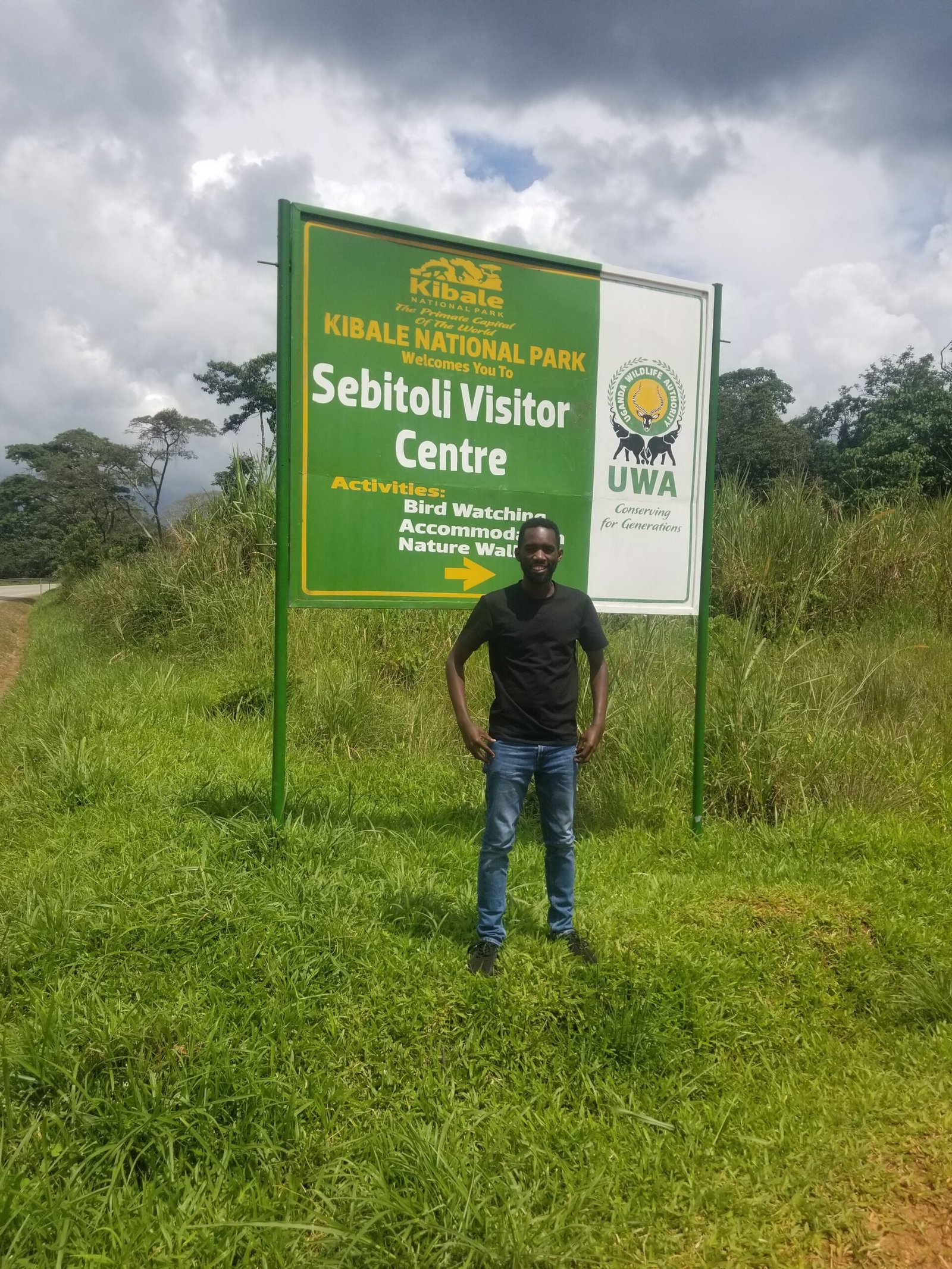
Uganda Birding and Chimpanzee Trekking
Kibale National Park, one of Uganda’s hidden gems and a sanctuary for wildlife enthusiasts and birding aficionados alike. Situated in the heart of the Pearl of Africa, Kibale National Park offers an extraordinary blend of lush rain-forests, diverse ecosystems, and unique opportunities for bird watching and chimpanzee trekking. In this article, we’ll take you on a virtual journey through the captivating world of Kibale, as we explore its rich biodiversity, unparalleled birding spots, and thrilling chimpanzee encounters.
Unveiling Kibale National Park : Kibale National Park, spanning over 795 square kilometers, is nestled in southwestern Uganda, near the town of Fort Portal. It’s renowned for its diverse habitats, including tropical rainforests, swamps, and grasslands, making it a hotspot for birdwatchers and wildlife enthusiasts. Notably, the park’s vast expanse is a haven for over 375 bird species, making it a paradise for avid birders. Additionally, Kibale is famous for its impressive chimpanzee population, offering unforgettable experiences for those seeking to trek and interact with our closest relatives in the animal kingdom.
Birding Paradise: Kibale National Park boasts an incredible array of bird species that will delight any ornithologist. From the rare Green-breasted Pitta to the vibrant African Grey Parrot, the park is a treasure trove of avian diversity. Birdwatchers can embark on immersive journeys through the forest, where the melodious calls and vibrant plumage of birds are sure to capture your heart.
Kibale’s birding hotspots, such as the Bigodi Wetland Sanctuary, offer fantastic opportunities for spotting wetland birds, including the majestic Shoebill Stork. The lush vegetation, wetlands, and forested areas provide the ideal setting for birding enthusiasts to capture the perfect shot or simply enjoy the mesmerizing symphony of bird calls.
Kibale Forest is a prime birding spot with about 375 bird species, including six Albertine Rift endemics. It is an excellent birding spot with habitats ranging from wet and dry tropical forest to woodland and savannah.
The number one sought-after bird in the Kibale Forest is the green-breasted pitta. This “mega” has recently become available, though finding it still takes a good measure of luck.
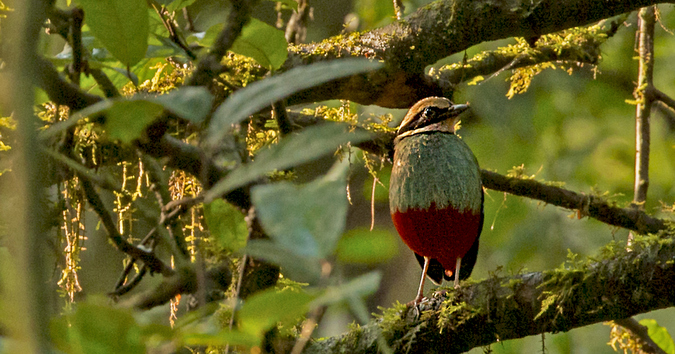 A green-A breasted pitta in Kibale National Park, Uganda
A green-A breasted pitta in Kibale National Park, Uganda
Kibale offers an impressive bag of goodies replete with gems such as various forest robins, scores of brown and scaly-breasted illadopses, brown-chested alethe, phantom-like black-eared and Abyssinian ground-thrushes, joyful and Toro olive greenbuls, black-bellied seedcracker, collared and black-capped apalis, grey-throated, yellow-spotted and yellow-billed barbets, blue-throated roller, black bee-eater, crowned eagle, red-chested owlet, African grey parrot, African finfoot, afep and white-naped pigeons and the comical, hulking great blue turaco.
The Bigodi Wetland Sanctuary within the park is a great haunt for specials such as speckled tinkerbird, speckle-breasted woodpecker, white-spotted flufftail, snowy-crowned robin-chat, Bocage’s bushshrike, and western nicator. Nearby patches of papyrus support the shy and cautious white-winged swamp-warbler.
Uganda Chimpanzee Trekking Adventure
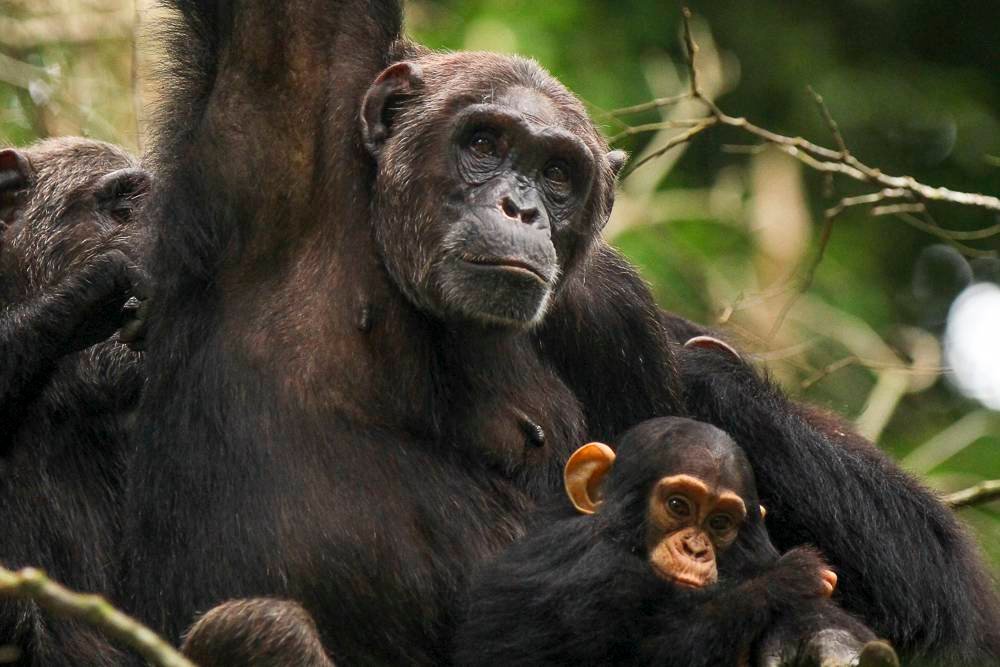
In addition to its avian wonders, Kibale National Park is renowned for its remarkable chimpanzee trekking experiences. The park hosts one of the largest populations of chimpanzees in Uganda, making it an ideal destination for primate lovers. Guided treks through the dense forests lead you to these incredible creatures, allowing you to witness their captivating behavior up close.
Chimpanzee tracking in Kibale is not only thrilling but also educational, as expert guides provide insights into the chimps’ social structure, habits, and conservation efforts. You may also encounter other primates, such as red-tailed monkeys and black-and-white colobus monkeys, further enhancing your wildlife adventure.
Exploring Kibale National Park
Aside from birding and chimpanzee trekking, Kibale National Park offers a myriad of other enchanting experiences. The park’s diverse ecosystems provide opportunities for nature walks, where you can encounter a wealth of flora and fauna. Explore the Crater Lakes or immerse yourself in the local culture by visiting nearby communities.
Accommodation options in and around Kibale National Park range from luxury lodges to budget-friendly campsites, ensuring you have a comfortable and immersive stay in the heart of nature.
Uganda Birding Tours and Beyond – Uganda Birding and Chimpanzee Trekking
For those looking to explore Uganda’s birding destinations, Kibale National Park is an absolute must-visit. It’s often included in Uganda birding tours, providing an exceptional opportunity to tick off numerous bird species from your checklist while enjoying the diverse landscapes the country has to offer.
Moreover, Kibale’s proximity to other iconic destinations like Queen Elizabeth National Park and Bwindi Impenetrable National Park makes it an integral part of Uganda’s wildlife and birding circuit. You can seamlessly combine your Kibale adventure with visits to these renowned parks for a complete Ugandan safari experience.
Kibale National Park in Uganda is a true gem for wildlife enthusiasts, birdwatchers, and adventure seekers. Its incredible birding opportunities, world-class chimpanzee trekking, and diverse landscapes make it a destination that stands out in the heart of Africa. Whether you’re captivated by the mesmerizing bird calls or longing to share a moment with our closest primate relatives, Kibale offers unforgettable experiences that will forever remain etched in your memory. So, plan your journey to Kibale National Park today and discover the untamed beauty of Uganda’s natural wonders. Your adventure awaits in the heart of this remarkable wilderness.
8. Rwenzori Mountains National Park
Rwenzori Mountains National Park in Uganda is a haven for Uganda Birding Safaris and hikers alike. With its remarkable avian diversity, captivating landscapes, and dedicated conservation efforts, it promises an unforgettable birding experience. Whether you’re a seasoned birder or a novice seeking to explore the avian wonders of Uganda, the Rwenzori Mountains should be at the top of your list for an adventure you’ll cherish forever. Don’t miss the chance to immerse yourself in the breathtaking world of birding in the Rwenzori Mountains.
Uganda is a birding enthusiast’s dream destination. With its diverse landscapes, lush forests, and vibrant avian population, it’s no surprise that the Rwenzori Mountains, one of Uganda’s most iconic national parks, stands as a top choice for birding adventures.
The Rwenzori Mountains in Uganda are home to about 220 bird species, including 19 Albertine Rift endemics, with habitat ranging from high elevation forest and open montane grasslands, to peat bogs, snowfields and glaciers.
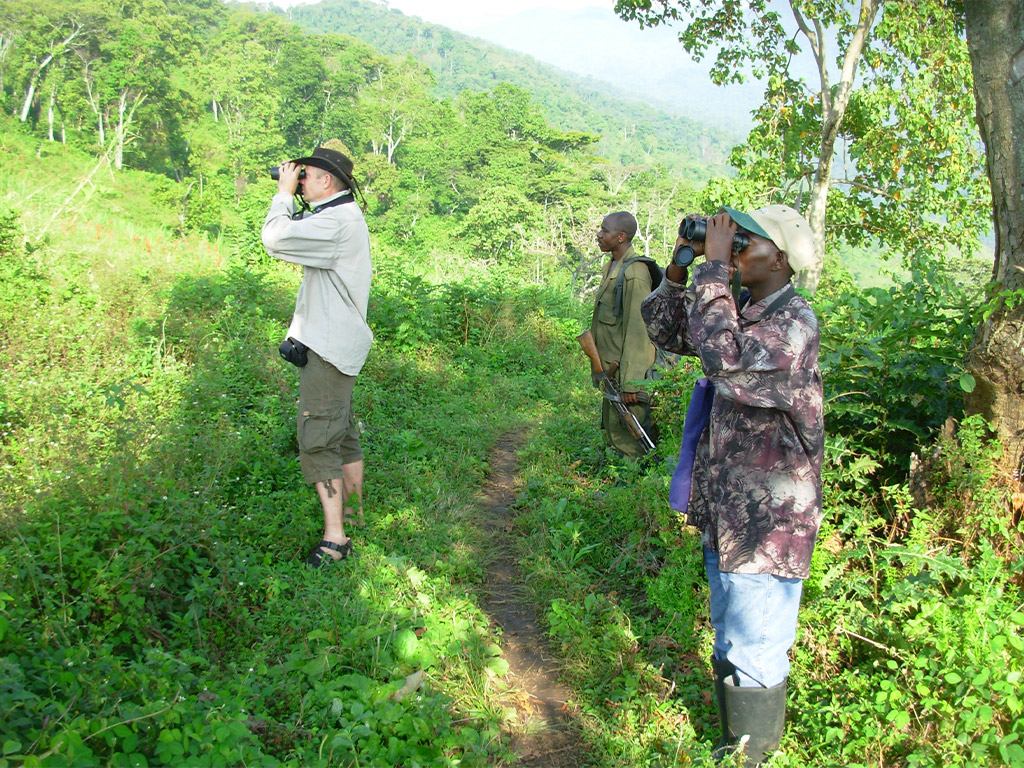 Birding in Kasangali, Rwenzori mountains, Uganda © Simon Espley
Birding in Kasangali, Rwenzori mountains, Uganda © Simon Espley
The Enchanting Rwenzori Mountains
The Rwenzori Mountains, also known as the “Mountains of the Moon,” offer a truly enchanting experience for hikers and birdwatchers alike. These towering peaks rise to over 5,000 meters, creating a unique habitat that is home to a plethora of bird species. Located in western Uganda, this UNESCO World Heritage site is characterized by its diverse ecosystems, including lush montane forests, bamboo thickets, and high-altitude moorland, all of which provide a perfect setting for birdwatching.
Birding in the Rwenzori Mountains: A Breathtaking Experience
- Rich Avian Diversity: The Rwenzori Mountains National Park boasts over 200 bird species, making it an ornithologist’s paradise. Among the most sought-after species are the Rwenzori turaco, handsome francolin, crimson wing, and the Rwenzori batis. The melodious calls and vibrant plumage of these birds make birdwatching a mesmerizing experience.
- Expert Guided Tours: For an optimal birding adventure, consider joining one of the expert-led Uganda birding tours in the Rwenzori Mountains. Local guides are well-versed in the park’s avian residents and can help you spot and identify even the most elusive birds.
- Prime Birding Spots: Several birding hotspots within the national park stand out, such as the Bigo Bamboo Forest, Bujuku Valley, and Lake Mahoma. Each location offers unique opportunities to observe endemic and migratory birds, and the breathtaking scenery makes your birding expedition even more memorable.
Why Choose the Rwenzori Mountains for Birding?
- Biodiversity: The park’s elevation gradient allows for a diverse range of bird species, from lowland forest dwellers to high-altitude specialists. It’s possible to observe multiple species in one day as you ascend through various habitats.
- Stunning Scenery: Beyond the avian wonders, the Rwenzori Mountains offer dramatic landscapes that serve as a backdrop for your birding adventures. Jagged peaks, cascading waterfalls, and pristine lakes create a picturesque setting for your hikes.
- Conservation Efforts: The Rwenzori Mountains National Park is dedicated to preserving its unique ecosystem and the species that call it home. By visiting and supporting responsible tourism, you contribute to the conservation of these magnificent birds and their habitats.
Logistics and Planning Your Uganda Birding Trip
Before set off for your Uganda birding journey to the Rwenzori Mountains, consider these practical tips:
- Best Time to Visit: The dry season, from December to February and June to August, is ideal for birding as it offers clear skies and more predictable weather.
- Accommodations: There are lodges and campsites within the national park, providing a comfortable and immersive experience for birdwatchers. It’s advisable to book in advance.
- Pack Accordingly: Be prepared with suitable clothing, hiking gear, and quality binoculars for an enjoyable birding expedition.
9. Lake Mburo National Park
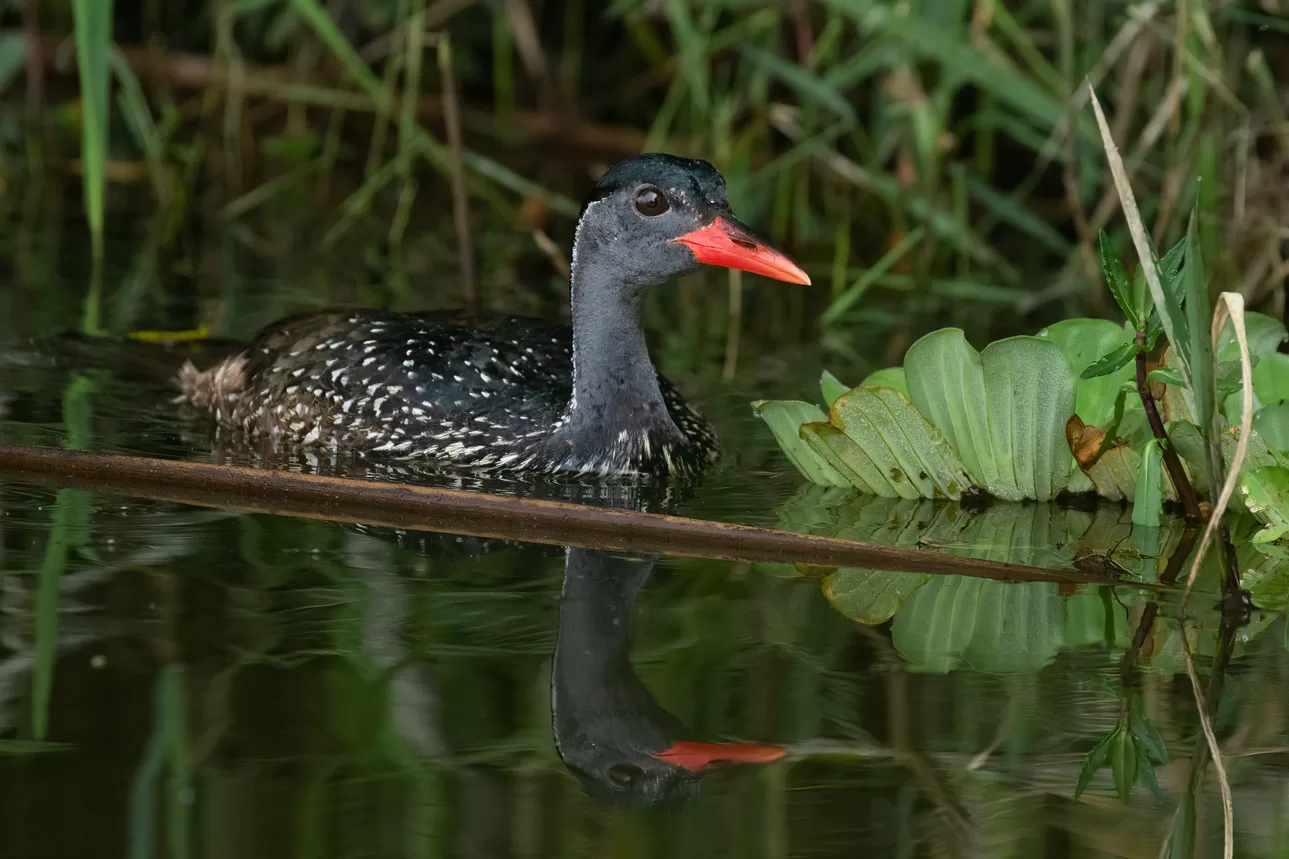
Lake Mburo National Park is a true paradise for birding-watching safaris. Its remarkable avian diversity, stunning landscapes, and expert-guided tours make it a top destination for birdwatchers worldwide. Whether you’re an experienced birder or a beginner, a visit to Lake Mburo promises a memorable and enriching birding experience.
This pristine wilderness is not only a haven for some of Uganda’s most incredible wildlife but also a paradise for birdwatching. Let’s explore the incredible birding opportunities that Lake Mburo National Park offers, making it one of the top birding destinations in Uganda.
Birding in Uganda: A Remarkable Experience
Uganda is renowned for its exceptional birding opportunities, boasting over 1,000 species of birds. Whether you’re a seasoned birder or a novice, the diverse range of bird species and the spectacular landscapes make Uganda a top birding destination. One of the most captivating spots in Uganda for birdwatching is Lake Mburo National Park.
Lake Mburo National Park: A Birder’s Paradise
- Rich Avian Diversity: Lake Mburo National Park is home to an impressive array of bird species, making it an ideal destination for birdwatchers. With over 350 species of birds, including several rare and endemic ones, you’ll have the opportunity to spot a variety of feathered wonders.
- Spectacular Scenery: Birding in Lake Mburo National Park is a visual treat. The park’s rolling savannahs, lush wetlands, and acacia woodlands provide diverse habitats for both resident and migratory birds. The scenic beauty of the park adds to the overall birding experience.
- Unique Species: Lake Mburo National Park is famous for harboring African Finfoot, Papyrus Gonolek, and White-winged Warbler. These are not only thrilling finds for avid birdwatchers but also provide excellent photographic opportunities.
- Expert Guided Tours: To maximize your birding experience, consider taking a guided birding tour in Lake Mburo National Park. Knowledgeable local guides can help you identify and locate the park’s avian treasures, ensuring a rewarding birding adventure.
Uganda Birding Tours: Exploring Lake Mburo National Park
When you engage in a Uganda birding tour, Lake Mburo National Park should undoubtedly be on your itinerary. Here’s what you can expect during your Uganda birding in Lake Mburo National park:
- Early Morning Excursions: The best time for birdwatching is in the early morning when the birds are most active. The park’s designated birding trails offer you the chance to witness a plethora of bird species in their natural habitat.
- Game Drives and Birding: While exploring the park on a game drive, keep your binoculars ready. You’ll often spot birds like the Crested Francolin, Coqui Francolin, and African Grey Hornbill while enjoying the larger wildlife sightings.
- Boat Safaris: Lake Mburo is one of the few places in Uganda where you can take a boat safari. This experience allows you to spot water-loving birds like the African Fish Eagle, White-backed Duck, and the majestic African Finfoot.
- Night Birding: For a unique adventure, try night birding in the park. Guided by the spotlight, you may encounter owls, nightjars, and other nocturnal species. Lake Mburo is home to the African Scops Owl and the African Wood Owl, both fascinating finds for nocturnal birders.
Birding Spots in Lake Mburo National Park
- Rwonyo Rest Camp: This area is an excellent spot to start your birding adventure. The acacia woodlands and nearby wetlands are teeming with birdlife. Expect to see the Blue-naped Mousebird, Lilac-breasted Roller, and Red-headed Lovebird.
- Lake Mburo: The lakeshore is home to numerous waterbirds, including the African Finfoot, Pied Kingfisher, and Great White Pelican. A boat safari on the lake will provide you with unrivalled opportunities to capture these birds in their element.
- Rubanga Forest: This forested area within the park is a unique ecosystem that offers sightings of forest birds like the Narina Trogon, Grey-cheeked Hornbill, and White-tailed Blue Flycatcher.
The park is home to about 320 bird species, which include red-faced barbet, brown parrot, barefaced go-away bird, black-billed barbet, blue-napped mouse bird, Nubian woodpecker, papyrus canary, papyrus gonolek, African finfoot and shoe bill.
There are a few very localized species in Uganda which only occur in Mburo, and topping that list are red-faced barbet, Tabora cisticola, green-capped eremomela, golden-tailed woodpecker, spot-flanked barbet, and grey penduline tit.
At the lake swamps, the main targets are African finfoot, papyrus gonolek, white-winged warbler, African water rail and white-backed night-heron. Yellow-throated leaflove chatter loquaciously in dense, waterside thickets and giant kingfishers wait patiently on overhanging branches.
Mixed woodlands are best for Coqui francolin, black-bellied bustard, African wattled plover, brown parrot, red-headed lovebird, barefaced go-away-bird, blue-napped mousebird, lilac-breasted and broad-billed roller, green wood-hoopoe, common scimitar bill, Narina trogon, Nubian woodpecker, trilling cisticola, northern black flycatcher, chin-spot batis, rufous-chested swallow, yellow-throated longclaw and southern red bishop.
Small numbers of the migratory brown-chested plover are regularly observed in the grasslands that access the park, in addition to the impressive Abyssinian ground-hornbill. Night drives may reveal African scops owl, marsh owl, Verreaux’s eagle owl, swamp and pennant-winged nightjars.
10. Budongo Forest
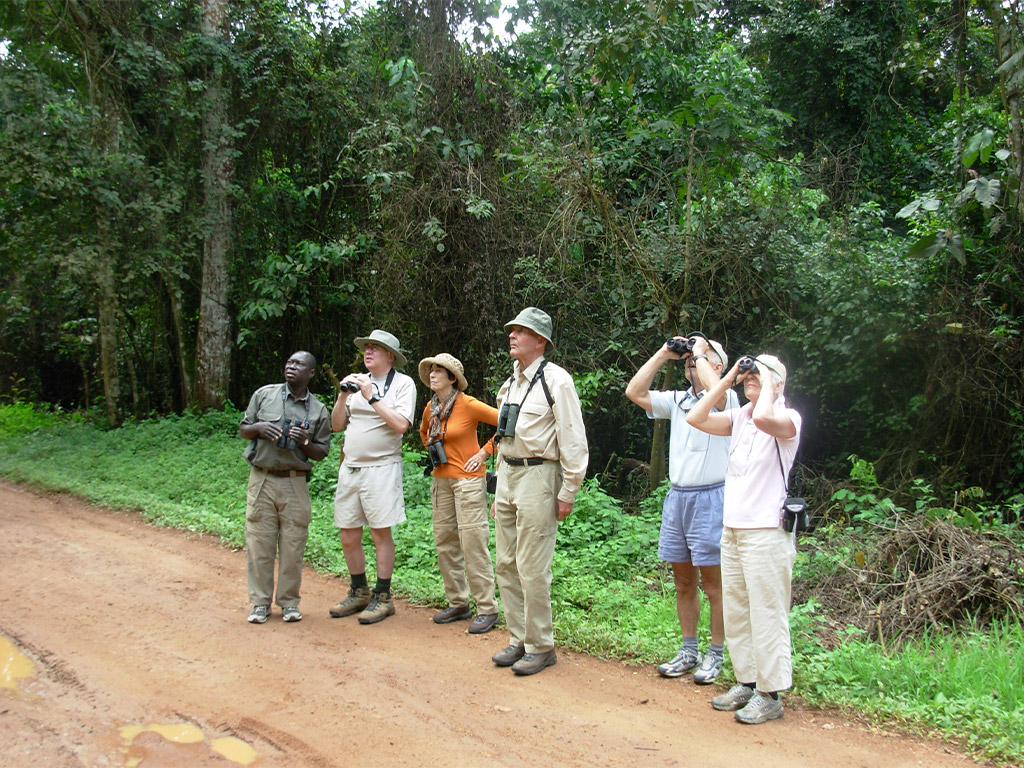 Africa Geographic clients birding the Royal Mile in Budongo Forest, Uganda
Africa Geographic clients birding the Royal Mile in Budongo Forest, Uganda
Budongo Forest has two main sections – Kaniyo Pabidi (Murchison Falls National Park), and the Royal Mile and Busingiro areas found south of Murchison. It lies at the edge of the Albertine Rift valley, protecting the most extensive natural forest area in East Africa.
Budongo is home to about 360 bird species. At Royal mile look out for the elusive and skulking Nahan’s francolin, the fleeting Cassin’s spinetail, and the dainty chestnut-capped flycatcher. Also search for the stunning chocolate-backed, blue-breasted and African dwarf kingfishers.
The forest is full of illadopses and alethes, and the diversity of greenbuls here is simply incredible. But for those who don’t fancy cryptic birds, there are plenty of more colourful species such as the white-thighed hornbill and black bee-eater. Other species include Cassin’s hawk-eagle, Ituri batis, black-collared lovebird and brown twins pot.
11.Birding in Mabira Forest
Mabira Forest Reserve in Uganda is an extraordinary destination for birding safaris. With its accessibility, diverse bird species, and expert-guided tours, it offers a unique opportunity for birdwatchers to immerse themselves in the captivating world of avian wonders. Whether you’re a local birder or an international traveler, Mabira Forest Reserve should be at the top of your list of Uganda birding destinations. So, pack your binoculars, prepare your checklist, and get ready for a birding adventure like no other in the heart of Africa. Birding in Mabira Forest Reserve is an experience you’ll treasure for a lifetime.
Mabira Forest Reserve stands out as one of the top destinations. Located just 54 kilometer’s from the capital city, Kampala, it’s easily accessible for both local and international birding enthusiasts. The forest covers an area of about 306 square kilometer’s, making it a substantial habitat for a diverse range of bird species.
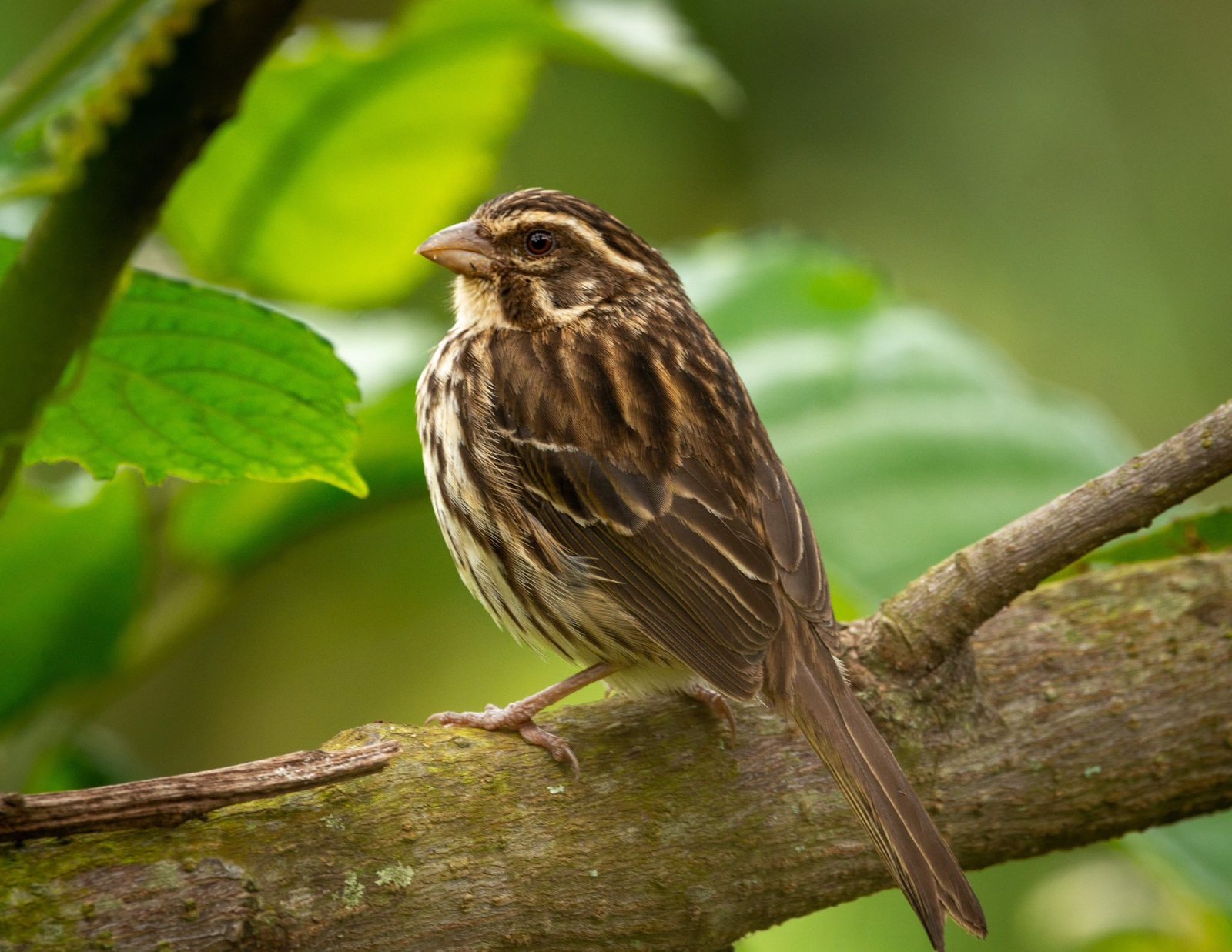
Birding in Uganda: A True Birdwatcher’s Paradise
Uganda has earned its reputation as the “Pearl of Africa” due to its stunning natural beauty and incredible biodiversity. Birdwatchers from around the world flock to Uganda to experience the thrill of spotting rare and captivating avian species. With over 1,000 bird species, including some of the most sought-after birds in the world, Uganda is a haven for birding enthusiasts.
Birding Spots in Uganda: Mabira Forest Reserve Stands Out
While Uganda offers numerous birding spots, Mabira Forest Reserve stands out for its unique combination of accessibility and pristine wilderness. The forest boasts over 300 bird species, and its diverse ecosystems provide a home for both forest and woodland birds. Whether you’re hoping to spot the magnificent African Grey Parrot, the striking Nahan’s Francolin, or the vibrant Blue-throated Roller, Mabira Forest has it all.
Guided Tours in Mabira Forest Reserve
For those seeking an expert’s guidance, Uganda Birding Tours offers a fantastic opportunity to explore Mabira Forest Reserve. Experienced guides will lead you through the forest, ensuring you don’t miss any of the remarkable bird species. These tours cater to birders of all levels, from beginners to seasoned experts.
A Year-Round Activity
One of the unique features of Mabira Forest Reserve is that it’s a year-round birding destination. Whether you visit during the dry season (December to February) or the wet season (March to May and August to November), the forest is always teeming with birdlife. The resident species are complemented by migratory birds, making it a dynamic and exciting place for birding throughout the year.
Must-See Bird Species in Mabira Forest
Mabira Forest Reserve is a treasure trove of avian wonders. Some of the bird species you can expect to encounter here include the Great Blue Turaco, Yellow-throated Tinkerbird, and the stunning African Pied Hornbill. Don’t forget to keep an eye out for the African Crowned Eagle soaring high above the canopy.
Tips for Birding in Mabira Forest
To make the most of your birding experience in Mabira Forest Reserve, be sure to bring the right gear. Binoculars, a field guide, comfortable hiking shoes, and appropriate clothing are essential. Also, carry a notepad to document your sightings.
Respect Nature and Wildlife
When birding in Mabira, it’s vital to be a responsible and ethical birder. Avoid disturbing the birds, their nests, or their habitat. Stay on designated trails and follow the guidance of your experienced guide.
Accommodation Options
While Mabira is a day trip destination for many, there are accommodation options nearby. You can choose to stay in lodges and campsites that provide a close-to-nature experience.
for more information visit www.zgd-safaris.com
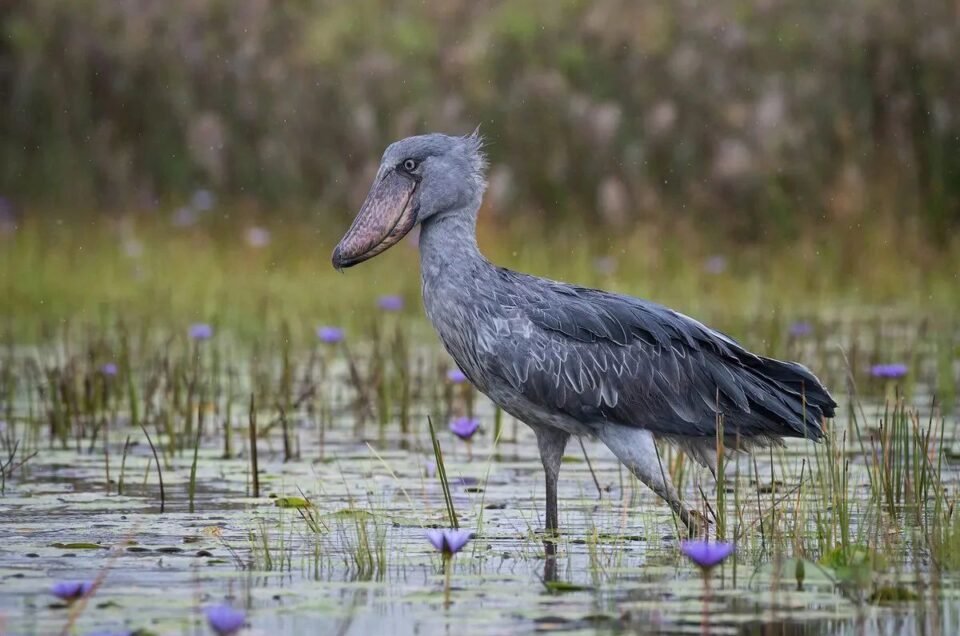
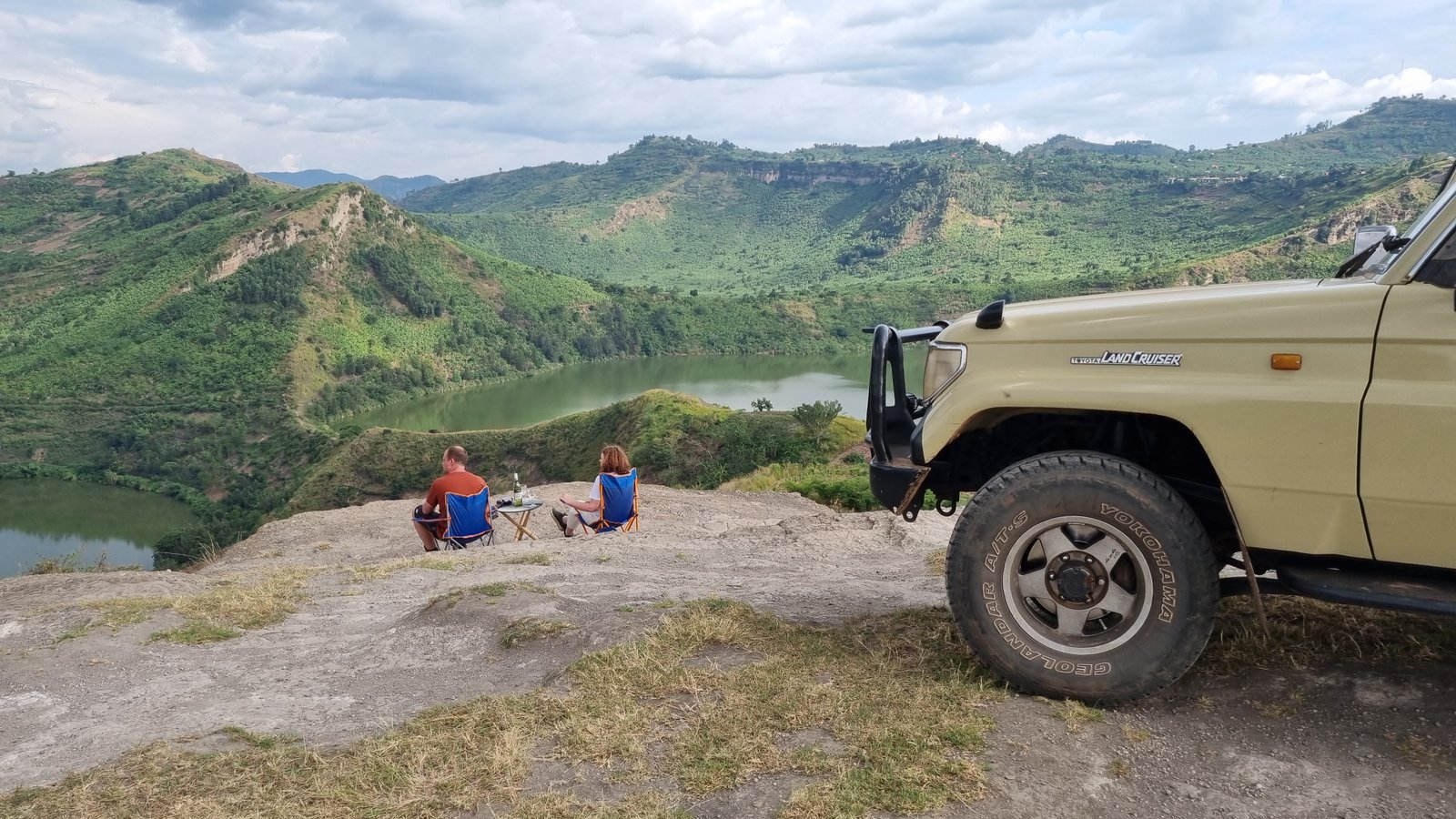
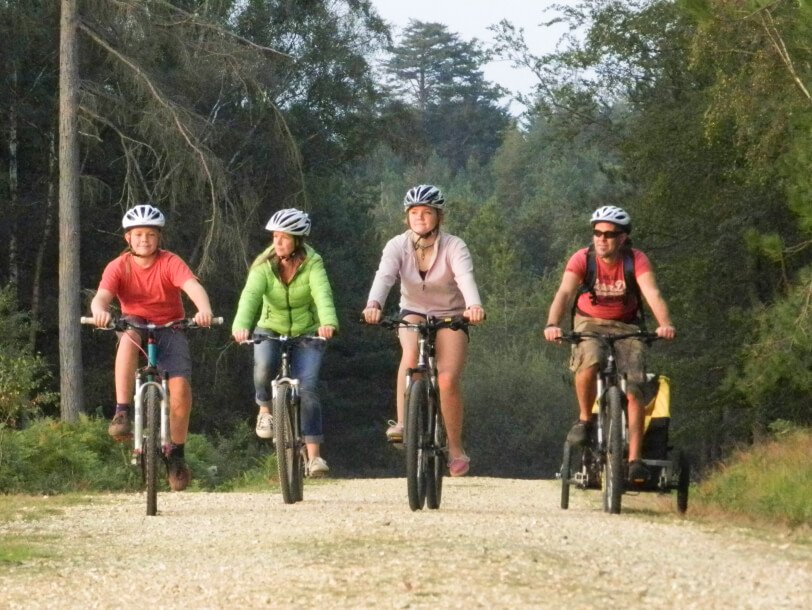
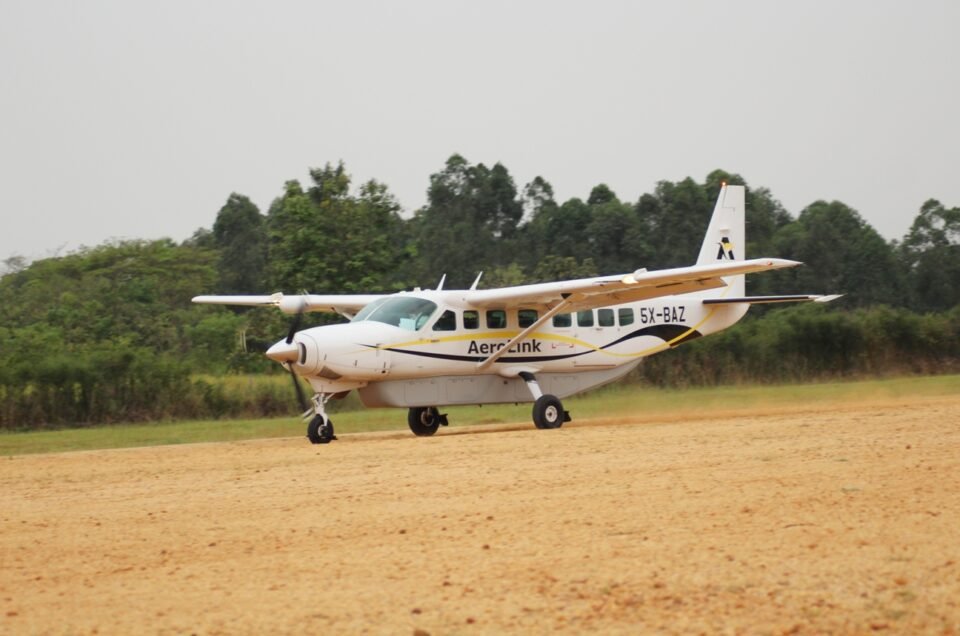






4 Comments
[…] Bwindi forest is a prime Uganda birding spot and was named as Africa’s number one birding spot by Africa Bird Club. If you have limited time in Uganda and you must choose only one park for birding then, Bwindi should be your choice. It is easily accessible for birding with birding trails in the forest leading to different area including the waterfall trail. It is home to about 350 species of birds which include 23 Albertine Rift endemics and 14 of which are recorded nowhere else in Uganda. There are excellent site guides in the communities who are very knowledgeable about the birds in the area especially the endemics. These join you as you take your trip into the forest re-enforcing the team you will have started wi… […]
[…] and Habituation in Kibale Forest Kibale Forest is one of the few places… Read More September 26, […]